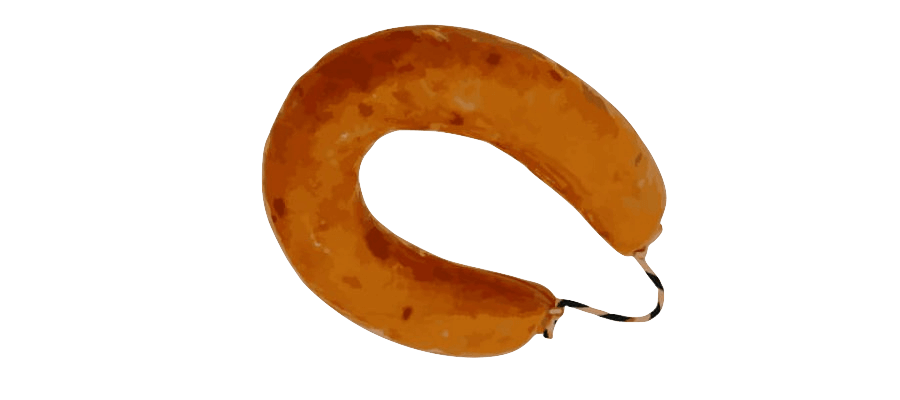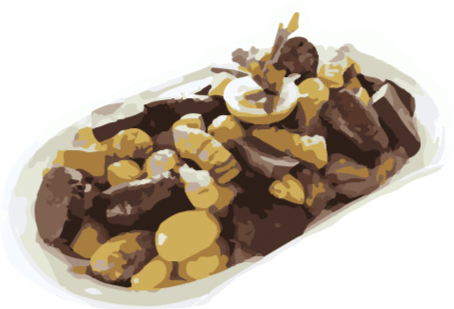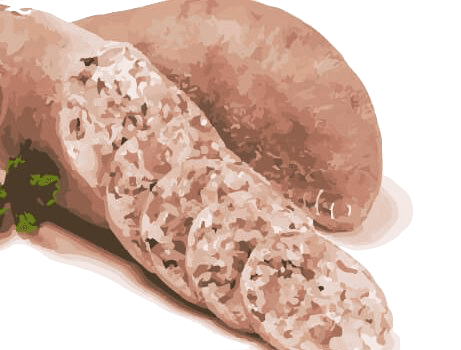The Portuguese have a long love story with pork. It’s actually hard to believe we weren’t the first ones to domesticate the feral boar, over 15.000 years ago. Sure, we’re not the country with the largest amount of traditional breeds, on the contrary. But we’re proud of our three original piggies: the Bísaro, the Alentejano (or Iberian pig) and the malhado de Alcobaça. As a people who love and respect this animal, during time we developed recipes and techniques that allowed us to give purpose to the whole animal, from head to tail. That urge came from the need to avoid wastefulness, but also to guarantee a reliable food source during the harsher months. And thus appear the many Portuguese sausage (known as enchidos) and cured meats. So, let’s stop ‘filling chouriços’ (i.e. wasting time) and let’s talk about them.


ALHEIRA
The alheira is a Portuguese sausage that is very typical of the North, and the most famous alheiras come from the regions of Mirandela, Vinhais, and Montalegre. Traditionally, the alheira has as main ingredients pork, chicken, olive oil, bread, and seasonings such as salt, garlic, and spicy or sweet paprika. There are also the (real) game alheiras (alheiras de caça), which may contain hare, pheasant, duck or partridge. In the final stages of making alheiras, they will spend some time in the smokehouse where they will lose water and acquire flavor from the smoke. The diversity of combinations between ingredients and time in the smokehouse make the different type of alheiras quite distinct amongst themselves. One of the particularities of the alheira is its doughy interior, that while not being homogenous, must really contain noticeable pieces of meat and bread. The alheira should be grilled, fried, or baked, and its texture and flavor should translate softness and creaminess, with the delicateness of the olive oil, a fair amount of salt, and an aromatic smokiness. Although it may not be the most popular way to eat this Portuguese sausage, it is very traditional to eat baked alheiras, sided with boiled potatoes and greens. There is also an important legend associated with the alheira: folk tradition has attributed the creation of the alheira to the New Christians, i.e. the Jews that were forced to convert by the Portuguese Inquisition during the 15th century. The alheira (at the time) would have been made with chicken, veal, and game meat (thus avoiding the use of pork, a forbidden ingredient for the Jews) and would be hung over the fireplace disguising as regular pork sausage, throwing off the unsuspecting goons of the Inquisition.

BELOURA
The beloura is a specialty from Minho that is not often seen outside of the region. It is not really a proper enchido or a cured meat, but more of a forbidden son between a blood sausage and a loaf of bread. The recipe requires rye, corn, and wheat flour, kneaded with yeast, blood, and sarrabulho-cooking water, alongside pepper and cumin. It is left to leaven, molded and cut, to then be boiled in water that is seasoned with garlic, salt, and bay. Be wary, though: it looks like bread, but you don’t eat it with butter. The beloura should be cut into fine slices and fried in lard (or pingue), to then make its way onto a plate of rojões à moda do Minho.

BUTELO
The butelo is a heavyweight Portuguese sausage from the North (Bragança), as it may even be used as an assault weapon. Pardon me, let me explain: the butelo is known to be the only bone chouriço, or were it not made up of vertebrae and pork ribs (we all know the best meat is near the bone), as well as cartilage and meat, encased in a stomach, bladder or pork tripe, tied with cotton string. As a seasoning, salt, paprika, bay, garlic, and wine are commonly used. The butelo is smoked for a few weeks and left to a cold cure. It’s large (1-2 kg) and it’s not pretty: a misshapen ball with protruding bones. After being slowly boiled, we’re left with a feast of soft meats, that are not too salty, with quite some presence of the paprika, and delicate bones to gnaw on. The butelo is traditionally sided with boiled cascas (or casúlas), which are dried bean peels.

CACHOLEIRA
The cacholeira is a typical Portuguese sausage from Alentejo, in particular of Portalegre. It’s the use of offal that makes this meat stuff so special, in particular, the use of pig liver, but it may also contain kidney, pancreas, spleen, and heart, as well as fat. Cacholeira’s main seasoning is salt, but also garlic, wine, or cumin. Later on, it’s blanched in boiling water and is ready for cooking, preferably roasted or boiled. In terms of flavor, this enchido is delicate, soft, and balanced in saltiness, with a balanced and aromatic fatty profile.

CHOURIÇO
The chouriço is one of the most diverse sausages of Portuguese tradition. Let’s see, the chouriço may even adopt fillings as surprising as pumpkin (chouriço de abóbora de Barroso-Montalegre) or honey and blood (chouriço doce de Vinhais). In general, the most common varieties of chouriço come from pork meat and fat — often from local pig breeds such as the Bísaro or Alentejano — which are seasoned with red pepper paste, wine, and garlic, and left to dry and smoke for a few days or weeks. The chouriço Mouro, a variety from the South, is made with pork blood or bloodied meat, which gives this chouriço a darker color, similar to a morcela. In terms of flavor, the chouriço is usually delicate and no too salty, with an aromatic fat.

FARINHEIRA
The farinheira is another special Portuguese sausage because it’s usually not made of meat, and is orange in color. It is made of well-minced pig’s fat, which is marinated for a few days in white wine, massa de pimentão (bell pepper paste), salt, and garlic. Afterward, it is covered in wheat flour and boiled, followed by another addition of white wine. In some regions, orange juice (!) is also added. After the farinheira paste is encased in beef casings, it is lightly boiled and dried in the smokehouse. The farinheira has a soft and delicate flavor, which is very aromatic and low in salt, where a velvety unctuosity prevails and compliments its supple texture.

MARANHO
The maranho is one of the most peculiar fresh Portuguese sausages, due to the use of goat (or sheep) meat instead of pork. Originally from Proença-a-Nova, it became a typical dish of the Beira Baixa. That being said, it is encased in a goat’s (or sheep’s) stomach filled with meat of those, pork belly, chouriço, presunto, rice, white wine, olive oil, and mint. Its flavor is more intense than that of some other enchidos dure to the goat or lamb’s meat, which is balanced by the aroma of mint. As it is a fresh enchido, it should be eaten little after being produced. It is cooked by boiling and may be finished in the oven.

MORCELA
You can’t speak of morcela (blood sausage) as a whole. The morcela constitutes a family of Portuguese sausages joined by blood. In general, they contain blood, bloody meat, and fat. Morcelas may also contain onion, rice, bread, and even orange. The use of condiments such as cumin and cloves is frequent but hardly mandatory. Most of the morcelas are blanched and then dried in the smokehouse (fumeiro). As the variety of morcelas is large (Portalegre, Guarda, Borba, Ilhas, etc.), it is hard to describe them as a whole. A good morcela should be concentrated in flavor, which should not excessively bloody but sweet, with crispy skin when fried or grilled, and a soft and aromatic interior, with well melted fat, and never dry. All things boiled, either meat or vegetable, are great sides. It shines when eaten with bread or broa.

ORELHEIRA E FOCINHO DE PORCO
Half of a pig’s face is dipped in brine and then hung to dry in the smokehouse, usually with hollow wood. You can find orelheira (pig’s ear) in many traditional dishes such as feijoada à Transmontana, cozido à Portuguesa and also as a snack with molho verde (salsa). In terms of taste, it varies largely according to the particular area of the face. The pig’s face in itself is similar to less meaty pork belly, and the orelheira has a more cartilaginous nature. Nonetheless, it’s smoky in flavor, highly textural due to the presence of collagen, and very buttery. It is also possible to find salt-cured orelheira.

PAIO
The paio do lombo is a Portuguese sausage that is very popular in the South, especially in Barrancos and Beja. It is mainly composed of pork loin, although some varieties also contain pork leg. The use of salt, pepper, and garlic are expected, and red pepper paste is an optional addition to the recipe. Another particular variety is the paio branco (white paio), which is typical of the Alentejo, and differs due to its light color and coating. This paio is made up of pork loin seasoned with only salt and garlic, which is then coated with boiled pork peritoneum and is then air-dried, without any smoking. The first varieties are usually consumed raw and with bread, where they present a soft, firm texture, with little fat and some saltiness.

PERNIL
The pernil fumado is simply a pig’s knee that is seasoned and dried in the smokehouse. This piece of pork is usually soaked and then roasted. It really does not require much of a fuss, as it easily develops into an array of delicious textures that vary between tender meat, gelatinous collagen, and crispy skin.

PRESUNTO E PALETA
The presunto is a mandatory petisco in every Portuguese tasca. One should mention, to begin with, that the presunto comes from the posterior legs and the paleta from the anterior legs. A whole pig’s leg is salted, washed, dried (with or without smoke), and then aged. Aging is surely the most critical stage in the development of the flavor of presunto and paleta, through several biochemical changes that result in a desired delicate texture and matchless olfactory and taste profile. Within certain limits, the rule of thumb says the longer the aging process, the better the presunto. When served, the slices should be very thin, thus revealing the transparency and unctuosity of the meat, and the delicate aroma with hints of fruit, caramel, butter, and nuts. The flavor should never be overpowered by salt and flavor intensity should unfold as you savor a slice. Presuntos and paletas coming from Portuguese breeds, especially the Alentejano pig (also known as the Iberian pig, and used for the world-renowned Spanish jámon ibérico) that delivers the Santana da Serra and Barrancos presuntos, are particularly complex due to the pig’s special diet (acorns) and fat distribution. Also, the best northern presuntos, such as those from Lamego and Marão, are usually made from the great quality breed of Bísaro pig.

SALPICÃO
This bulky and compact Portuguese sausage is composed of several pieces of pork loin (and sometimes leg), which are marinated for several days in a marinade of red or white wine, garlic, salt, pepper, bay, and paprika. Afterward, a big and cylindrical portion of the large intestine is filled with the meats and tied with cotton thread. The salpicão is then slowly dried in the smokehouse. The salpicão of Alentejo and Trás-os-Montes is of particularly good quality. When tasting a salpicão, one cannot help but notice the flavor of smoke and salt, and more timidly of wine and paprika, joined to a firm, lean texture that is hardly unctuous.
WHERE CAN I BUY THEM?
There are plenty of places in Porto to buy these wonderful Portuguese sausages and cured meats. However, we really do recommend the following shops:
Mercearia do Bolhão (Rua Formosa, 305)
Casa Lourenço (Rua do Bonjardim, 417)
Pérola do Bolhão (Rua Formosa, 279)
Comer e Chorar por Mais (Rua Formosa, 300)
Queijaria Amaral (Rua de Santo Ildefonso, 190)
Casa Chinesa (Rua de Sá da Bandeira, 343)
Casa São Miguel (Praça Mouzinho de Albuquerque 63)
Salsicharia Lindinha (Mercado do Bolhão)
Salsicharia Branquinha (Mercado do Bolhão)
Salsicharia Luísa (Mercado do Bolhão)



One reply on “Portuguese Sausage and Cured Meats: An Essential Guide“